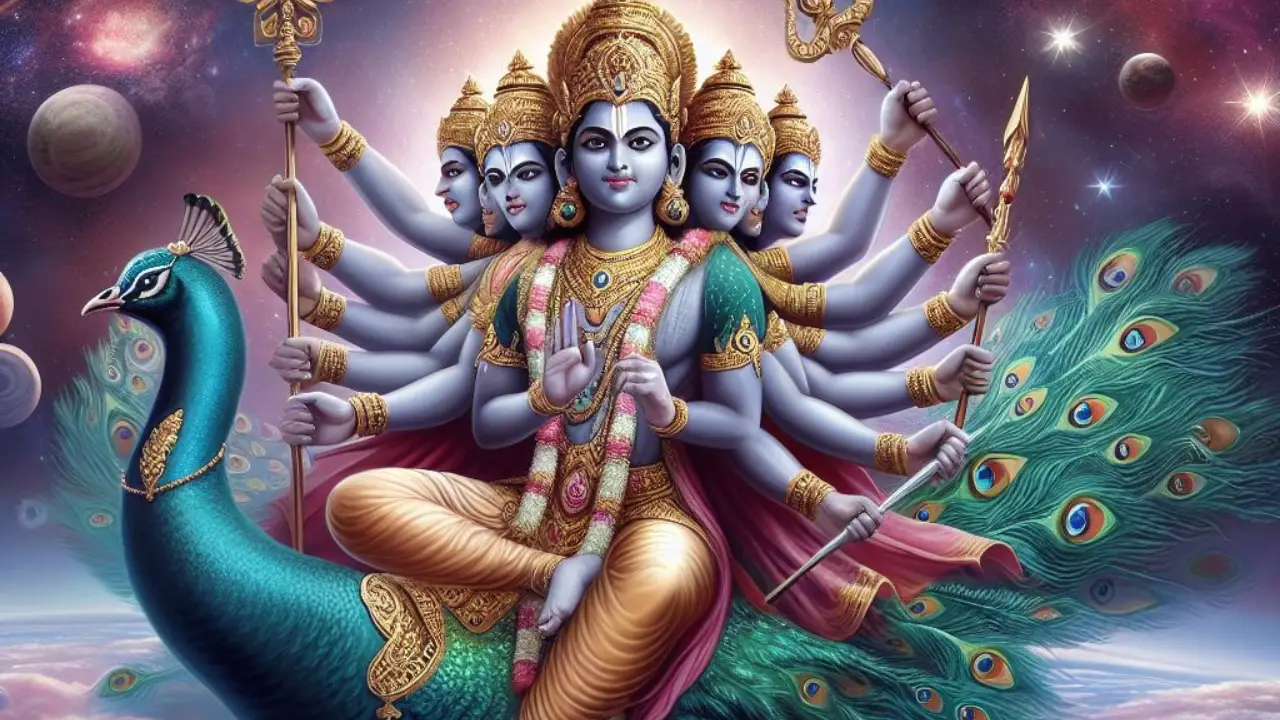In the vast pantheon of Hindu deities, Lord Kartikeya holds a prominent place as the God of War and Victory. Known by various names such as Murugan, Skanda, and Subrahmanya, he represents courage, valor, and triumph over adversity. The captivating legend of Lord Kartikeya offers insights into the rich tapestry of Hindu mythology.
Birth of Lord Kartikeya: The Divine Purpose
In the celestial abode of the gods, the Devas faced a formidable adversary in the form of demon Tarakasura. Prophecy held that only the son of Lord Shiva could vanquish this demon. Goddess Parvati, was determined to aid the gods. She focused her energy along with Lord Shiva and created Lord Kartikeya, who emerged as a radiant being with six heads, representing the six attributes of wisdom, dispassion, strength, fame, wealth, and righteousness.
The Child of the Ganges: The Fascinating Tale
Goddess Parvati entrusted Lord Kartikeya’s care to the six Krittika stars, who nourished him with divine love and the celestial Ganges river’s waters. Under their guidance, he grew into a valiant and intelligent young warrior. His divine persona radiated power and wisdom, endearing him to all who encountered him.
Lord Kartikeya’s Mission: The Battle Against Tarakasura
Lord Kartikeya embarked on a mission to defeat the formidable demon Tarakasura and bring peace to the heavens. Armed with his potent spear called “Vel” and astride his vahana, the peacock, he led the army of Devas into battle. The celestial beings hailed their resplendent commander, and the clash between good and evil ensued.
The Battle of the Ages: Triumph of Virtue
The battle raged on, testing Lord Kartikeya’s mettle and valor. With each strike of his Vel, the forces of evil trembled, and the Devas found new hope. The combat was intense, but Lord Kartikeya’s divine prowess proved insurmountable. Finally, after a fierce confrontation, he slew the malevolent Tarakasura, liberating the heavens from his tyranny.
Symbolism and Iconography: Decoding Lord Kartikeya’s Essence
Lord Kartikeya’s depiction carries profound symbolism. His six heads signify an omniscient and all-encompassing perspective. The peacock represents subduing pride and arrogance, while the spear embodies the intellect’s sharpness. His mount’s association with rain and vegetation underscores the cyclical nature of life and death.
Lord Kartikeya’s Universal Appeal: The God of Courage and Wisdom
Lord Kartikeya’s influence extends beyond Hinduism, resonating with people of various cultures and beliefs. He symbolizes the human spirit’s indomitable nature, inspiring courage, wisdom, and determination to overcome life’s adversities.
Worship and Festivals: Honoring the God of War
Devotees of Lord Kartikeya celebrate his valor and victory through numerous festivals, with “Skanda Shasti” being one of the most prominent. This six-day festival commemorates the deity’s defeat of Tarakasura and instills devotees with the belief that good shall always triumph over evil.
Lord Kartikeya in Scriptures: References and Epics
Lord Kartikeya’s significance is not limited to one sacred text. References to him can be found in various Hindu scriptures and epics like the Puranas, Mahabharata, and Ramayana, establishing his venerable status in the pantheon of gods.
Lord Kartikeya Today: Embodying Courage in Modern Times
Even in contemporary society, the valor of Lord Kartikeya remains an inspiration. His stories continue to kindle the flame of courage, guiding individuals to face challenges with determination and emerge victorious.
Conclusion
The captivating legend of Lord Kartikeya, the God of War and Victory, weaves a tapestry of courage, valor, and triumph. His tale stands as a timeless reminder that the indomitable spirit, armed with wisdom and determination, can overcome any obstacle. From ancient scriptures to modern minds, Lord Kartikeya’s legacy endures, symbolizing the victory of good over evil, making him an eternal source of inspiration.

